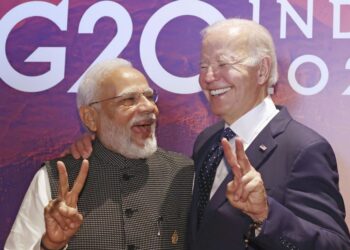BY PAWAN CHETAL
There exist tremendous investment opportunities in the non-conventional energy sector for the Indian diaspora as the sector has seen significant evolution and growth in the past few years
The Indian energy sector is one of the most diversified sectors in the world. Energy in India is generated from commercial sources like coal, lignite, natural gas, oil, hydro and nuclear power as well as other viable non-conventional sources like wind, sunlight, and agricultural and
domestic waste. The energy sector in India has been growing at a rapid rate and is expected to attain greater heights in future.
India has set an ambitious target to achieve a capacity of 175 GW (gigawatts) worth of renewable energy by the end of 2022, and expand it to 500 GW by 2030. This is one of the world’s largest expansion plans in renewable energy.
The country was the second largest market in Asia for new solar PV capacity and third globally (13 GW of additions in 2021). It ranked fourth for total installations (60.4 GW), overtaking Germany (59.2 GW) for the first time.
India’s installed renewable energy capacity has increased 396% in the last eight years and stands at more than 159.95 GW (including large hydro), which is about 40% of the country’s total capacity (as of March 31, 2022). The installed solar energy capacity has increased by 19 times
in the last eight years, and stands at 56.6 GW as of June 1, 2022. The installed renewable energy capacity (including large hydro) has increased from 76.37 GW in March 2014 to 159.95 GW in May 2022, i.e. an increase of around 109.4%.
The investment climate is very positive in the Indian energy sector. Due to the surge in the sector, it has witnessed higher investment flows than envisaged. As much as $70 billion (about ₹5.2 lakh crore) has been invested in renewable energy across the country in the past seven years.
The government has initiated several policies for the energy sector to promote and garner investments from NRIs/PIOs. Foreign Direct Investment (FDI) is allowed up to 100% in respect of projects relating to electricity generation, transmission and distribution, other than atomic
reactor power plants. There is no limit on the project cost and quantum of FDI. The Foreign Investment Implementation Authority (FIIA) has been established to provide one-stop after-care service to foreign investors by helping expedite approvals and clearances and sort out operational problems with other government agencies. The FIIA acts as a single-point interface between the investors and government agencies including administrative ministries, state governments, pollution control boards, the Directorate General of Foreign Trade, regulatory authorities, tax authorities and the Company Law Board, among other entities.
GDP GROWTH OVERTAKES ENERGY GROWTH
India is all set to exceed the goals set out in its Nationally Determined Contribution (NDC) under the Paris Agreement. The emission intensity of India’s economy will improve by 40% from 2005 to 2030, above the 33-35% set out in its existing NDC. Emission intensity is defined as the total
amount of greenhouse gas emissions emitted for every unit of GDP. Importantly, it counts emissions beyond those related to energy (such as emissions from agriculture), and greenhouse gases beyond carbon dioxide (such as methane). It is distinct from the energy intensity of the
economy, which is how much energy a country uses to generate wealth— measured in terms of its GDP.
As per “India Energy Outlook 2021” of the International Energy Agency (IEA), the GDP of India has increased six-fold between 1990 and 2019, whereas final consumption of energy has only increased two and a half times, indicating a rapid improvement in energy intensity in these three decades. This is primarily due to a shift away from biomass as primary fuel in the residential sector, the share of which reduced from 48% (1990) to 18% (2019), due to enhancement of electrification and liquified petroleum gas (LPG) penetration.
Efficiency gains from shifting from biomass (with very low conversion efficiency of 5-10%) to higher efficiency LPG and electricity are responsible for 60% decline in energy intensity during the period. As per the analysis in BUR-2, India’s energy intensity (at 2011–12 price level
GDP) decreased from 0.2732 mega joule per rupee (MJ/INR) in 2011–12 to 0.2401 in 2016–17, indicating a reduction of more than 12% in five years. The decline is being attributed to the fact that GDP growth is faster than energy growth, which is made possible by a larger share of service sector growth in the country.
The share of non-fossil fuels in electricity generation has reached almost 60%, well above the 40% that India pledged. India’s leadership in the deployment of clean energy technologies is set to expand its market for solar PV, wind turbine and lithium-ion battery equipment to over $40
billion per year by 2040. In this case, and especially in the sustainable development scenario where the equipment markets for solar, wind, batteries and water electrolysers rise to $80 billion per year, the industrial and commercial opportunities from clean energy are even larger.
The government has placed major emphasis on development of clean energy sources in the country. The sector is one of the major contributors to infrastructure development in India and with the newer emerging themes (green hydrogen, storage, electric vehicles, solar cell and electrolyser manufacturing and so on), it is leading the way for sustainable development and creating a better future.
ATTRACTING FDI
FDI in India’s renewable energy sector stood at $1.6 billion (₹121.05 billion) in financial year (FY) 2021-22. The investment is the highest ever in the Indian renewable sector in a year.
The federal tax incentives, or credits, for qualifying renewable energy projects or equipment include the Renewable Electricity Production Tax Credit (PTC), the Investment Tax Credit (ITC), the Residential Energy Credit, and the Modified Accelerated Cost-Recovery System (MACRS).
Cooperation agreements have been signed by the Indian government with other countries, including Denmark and the UK. The areas of cooperation include forecasting and scheduling of off-shore measures to develop and sustain a highly efficient wind industry, onshore as well as offshore; technical capacity building for management of off¬shore wind projects; measures to ensure high quality of wind turbines, components, and certification requirements.
The Grid Connected Solar Roof Top Programme aims to achieve a cumulative capacity of 40 GW from Rooftop Solar (RTS) projects by the end of 2022. The programme will be implemented with total central financial support of ₹11,814 crore through DISCOMs.
India has been one of the top-performing clean energy economies in the 21st century, registering the fifth highest five-year rate of investment growth and eighth highest in installed renewable energy capacity, according to some of the research reports.
INCREASE IN RENEWABLE ENERGY CAPACITY
According to publicly available data, since March 2014 the sector has seen a growth of 2.73 times in total installed renewable energy capacity in the country. In line with its announcement at the COP26 summit in Glasgow to increase the non-fossil energy capacity to 500 GW by 2030, coupled with the target to become a net zero carbon emitter by 2070, India is set to push the pedal to accelerate the pace of development.
The peak electricity demand of the country has been showing a positive trend of increasing. During the last year, the power demand initially reduced due to Covid-19. However, there has been an encouraging growth rate from September 2020 and has reached peak demand of
around 190 GW. The increase is on account of revival of the economic activities in the country. ‘Vocal for local’ and Atmanirbhar Bharat have also added to the increasing demand for power.
Over the last eight years, per capita electricity consumption has reported consistent growth from 914 kWh in 2012- 13 to 1,208 kWh in the last fiscal, an increase of 32%.
India jumped 115 positions to 22nd (2020) from 137 (2014) in the World Bank’s ‘Ease of Doing Business – Getting Electricity’ ranking. The Indian power sector is forecast to attract investments worth $128.24 bn to $135.37 bn between FY19-23. The future of the sector looks bright since by 2026-27 the country’s power generation installed capacity will be close to 620 GW, of which 38% will be from coal and 44% from renewable energy sources.
The author is founder and CEO, www.oneconsulting.in, and has over 35 years’ experience in power, telecom and infrastructure.








